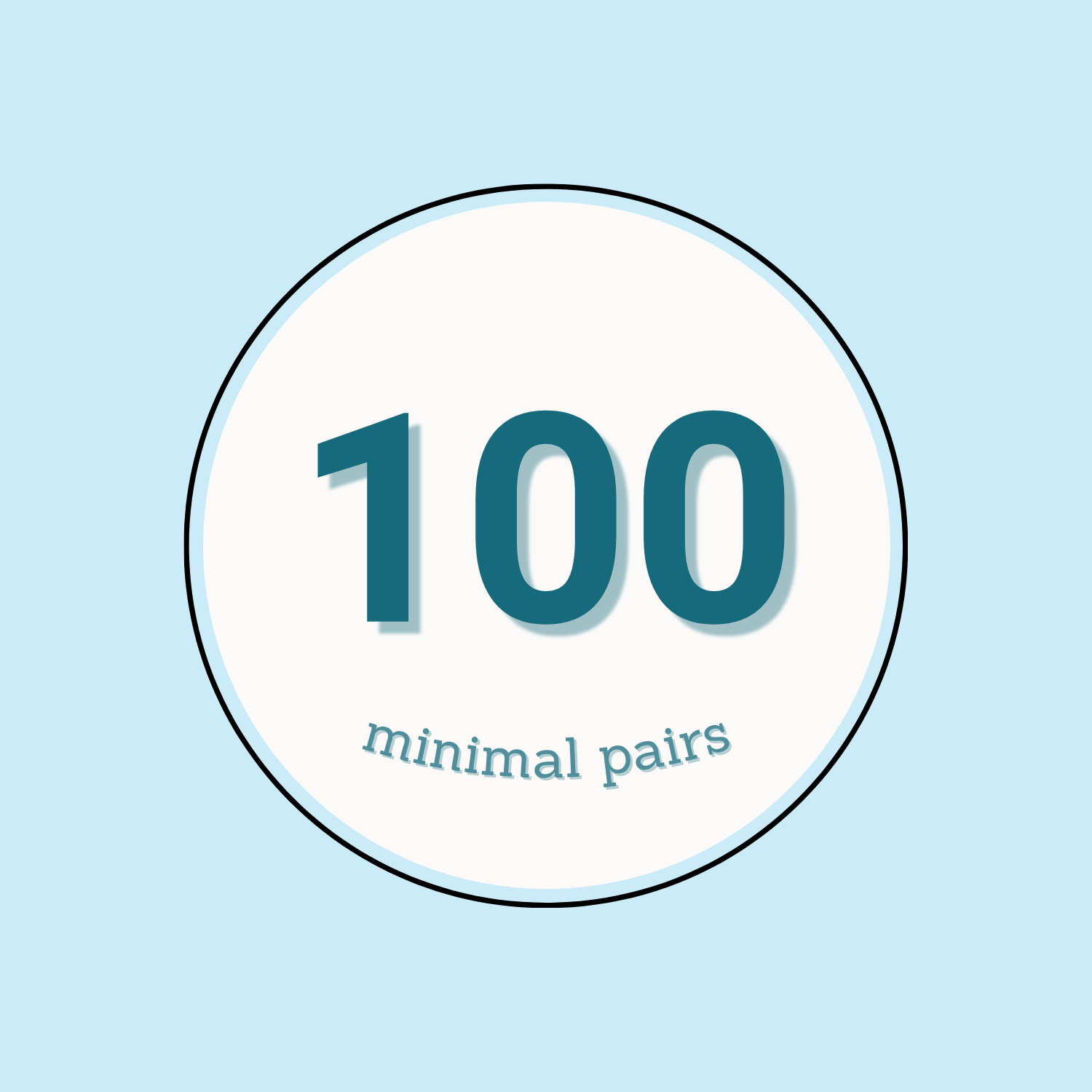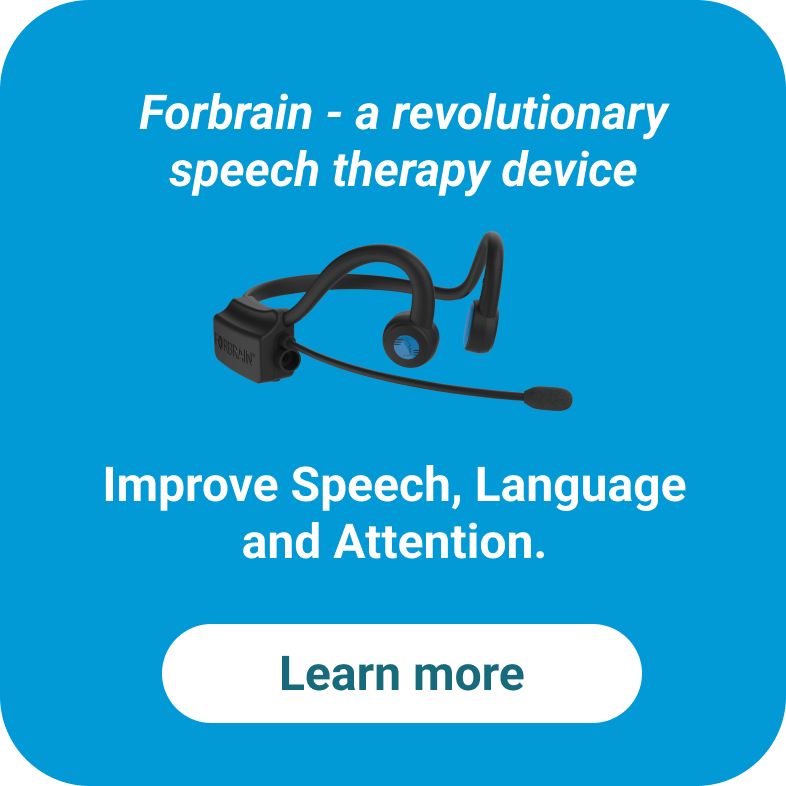List of 100 Minimal Pairs to Use in Speech Therapy
 Natalie Fitzgerald
Natalie Fitzgerald Speech-Language Pathologist
July 26, 2023

What are Minimal Pairs | Minimal Pairs Word List | When to Use the Therapy | How to Use the Therapy | Games and Activities | Using Forbrain
Minimal pairs are word pairs that differ by only one sound. For example, “car, tar”, “light, white”, and “sip, ship” are all examples of minimal pairs. Minimal pairs are important because this single sound difference changes the meaning of the word. Minimal pair speech therapy helps to highlight the differences in sound production, word meaning, and overall communicative effectiveness.
What are Minimal Pairs
As mentioned above, minimal pairs are words that differ by only one phoneme (sound). An important feature of minimal pairs is that both words must be real words. So, “sun” and “fun” would be considered minimal pairs but “sun” and “mun” would not.
Minimal pairs are commonly used to treat children who use something called a phonological process. Phonological processes are patterns of sound replacements where children replace more difficult sounds with easier sounds.
Common phonological processes include fronting (replacing the “k or g” sounds with “t or d” sounds, gliding (replacing “R or L” with “W or Y” and final consonant deletion (leaving off the ending sounds in words so “cat” becomes “ca” or “boot” becomes “boo”).
A key part of minimal pairs in speech therapy is familiarizing the child with the different meanings for each word. So, if a child says “tape” instead of “cape” when talking about a superhero, they need to understand the meanings of both words to recognize why the word they used was incorrect. Doing this helps them better understand what they are actually saying versus what they are trying to say, and why using the wrong word may result in them being misunderstood.
Minimal Pairs Word List
T and K Minimal Pairs
| Top | Cop |
| Tight | Kite |
| Torn | Corn |
| Tame | Came |
| Tall | Call |
| Tail | Kale |
| Bat | Back |
| Pit | Pick |
| Ate | Ache |
| But | Buck |
| Sit | Sick |
| Rate | Rake |
D and G Minimal Pairs
| Date | Gate |
| Deer | Gear |
| Drip | Grip |
| Down | Gown |
| Doe | Go |
| Bid | Big |
| Led | Leg |
| Mud | Mug |
| Bud | Bug |
| Bed | Beg |
S and TH Minimal Pairs
| Sick | Thick |
| Sing | Thing |
| Sink | Think |
| Sum | Thumb |
| Bass | Bath |
| Pass | Path |
| Mouse | Mouth |
R and W Minimal Pairs
| Reed | Weed |
| Red | Wed |
| Rate | Wait |
| Real | Wheel |
| Row | Woah |
| Rest | West |
| Rip | Whip |
| Rut | What |
| Ring | Wing |
| Rig | Wig |
| Rag | Wag |
L and W Minimal Pairs
| Lay | Way |
| Lip | Whip |
| Leap | Weep |
| Leave | Weave |
| Lick | Wick |
| Lake | Wake |
| Late | Wait |
| Low | Woah |
| Lock | Wok |
| Light | White |
F and V Minimal Pairs
| Fan | Van |
| Face | Vase |
| Fine | Vine |
| Fear | Veer |
| Fat | Vat |
| Fairy | Very |
| Safe | Save |
| Off | Of |
| Life | Live |
| Gif | Give |
F and TH Minimal Pairs
| Free | Three |
| Fin | Thin |
| Four | Thor |
| First | Thirst |
| Fought | Thought |
| Reef | Wreath |
| Deaf | Death |
S and T Minimal Pairs
| Sun | Ton |
| Sick | Tick |
| Sour | Tower |
| Seam | Teem |
| Sell | Tell |
| Songs | Tongs |
| See | Tea |
| Face | Fate |
| Bus | But |
| Pass | Pat |
| Less | Let |
| Miss | Mitt |
| Nice | Night |
Final Consonant Deletion Minimal Pairs
| Boo | Boot |
| Saw | Sock |
| Lay | Lace |
| Me | Mean |
| See | Seed |
| Day | Date |
| Go | Goat |
| Pay | Pace |
| Way | Wake |
| No | Note |
Blends Minimal Pairs
| Back | Black |
| Peas | Please |
| King | Cling |
| Goo | Glue |
| Foe | Flow |
| Tie | Try |
| Dip | Drip |
| Keep | Creep |
| Go | Grow |
| Fog | Frog |
| Soon | Spoon |
| Sick | Stick |
| Side | Slide |
| Set | Sweat |
| So | Snow |
| Sell | Smell |
| Sip | Skip |
When to Use Minimal Pairs Speech Therapy
Minimal pairs therapy is most commonly used when children use phonological processes as their sound errors. Meaning, when a child uses an “easier” sound instead of using a “harder” sound. For example, in the common phonological process “gliding”, a child may use a “W” or “Y” sound instead of the harder “R” or “L” sound.
They may say “wabbit” instead of “rabbit” (note: this is not a minimal pair because “wabbit” is not a real word), or “won” instead of “run”.
Most phonological processes are not addressed before a child turns 3, as most sound errors are considered “age-appropriate” until that time.
Minimal pairs are appropriate to use with most children, as long as the child is able to understand the meaning of both word pairs. So, it would be appropriate to use the word pair “Go / Doe” with a 4 year old who uses fronting, but it would not be appropriate to use “Dull / Gull”.
- By age 3 years, the phonological processes of fronting (using “T” for “K”), assimilation (using the same consonant more than once in a word such as “mom” for “mop” or “bib” for “big”), and final consonant deletion (leaving off the final sound in a word such as “buh” for “bus”) should no longer be present in a child’s speech.
- By 5 years of age, cluster reduction (reducing sound blends to a single sound, such as “seep” for “sleep” or “kip” for “clip”) is no longer considered appropriate.
- By 6-7 years of age, gliding (“W” for “R or L”) is no longer considered age appropriate.
For more information regarding when specific speech sounds may be addressed, please see the chart here. Additionally, for a more comprehensive list of phonological processes, their descriptions, and when they should disappear, see the chart here.
If you are concerned that your child uses any of the phonological processes described above, your best course of action is to first consult with a speech-language pathologist (SLP). A certified and licensed SLP will be able to tell you if your child needs therapy or if they would benefit from minimal pairs speech therapy.
How to Use Minimal Pairs in Speech Therapy
Using minimal pairs in speech therapy, or at home, takes some practice. Minimal pairs are often difficult for a child when they are first introduced, and you can’t start at the same place with every child.
Some children may be able to move through some steps very quickly or skip them entirely, while others may take more time to make progress. In general, minimal pairs therapy follows the following sequence:
Identify the Minimal Pair Targets
Select a small number of minimal pairs that are appropriate for your child based on their age and phonological processes.
Familiarize the Child
Show the child pictures of all the words and ensure they understand all their meanings.
Auditory Bombardment
Take a few minutes to read the word pairs to your child. They are allowed to play with another quiet activity during this time if they choose.
Auditory Discrimination
Can the child hear the difference between these words? Using pictures to represent each word, show the child the 2 minimal pair words and ask them to point to the word you say. Sometimes, you may need to hide your mouth so you know they are really hearing the difference and not seeing it.
Practice the Words
Now, it is the child’s turn to practice. This phase of therapy will take the longest, and continues until they are able to say their words correctly in conversation. It can also be broken down into levels, such as:
- Practicing in single words. Like it sounds, this first level involves the child practicing the words by themselves. They may practice saying “go / doe” one time, or several times in a row until they can do so without error.
- Practicing in phrases. At this next level, the child may work on using the words in simple phrases, such as “the doe can go” or “Big doe. Bus go.”
- Practicing in sentences. At this level, the child works on using their minimal pairs in even longer sentences, such as “I can go to the woods and see a doe eating grass.”
- Practicing in structured conversation. Here, the child is working on carrying their skills into real-life conversations, but they are still given support by their SLP or parent/caregiver.
Games & Activities with Minimal Pairs
When using minimal pairs in speech therapy, as with all therapy, it is important to keep games fun and engaging while also allowing the child time to practice their sounds. Some games that you can play with your child to work on minimal pairs speech therapy include:
Minimal Pairs Memory Game
In this game, you will need a set of cards containing minimal pair words appropriate for your child. These could be purchased or made at home.
Simply flip all the cards upside down then take turns flipping 2 cards at a time. If the cards match (or, in this case, if they are the minimal pair) that player gets to keep them. Whoever gets the most matches wins!
Minimal Pairs Sensory Bin
Sensory bins are so easy to make! Typically, bins are filled with dry rice and/or beans, and then objects or laminated pictures are mixed inside. The child will dig through the bin to find their minimal pairs, practicing their sounds as they go.
Minimal Pairs Silly Sentences
Making silly sentences is a great activity for a mid-late elementary schooler. For this game, both minimal pair words must be used in the same sentence, and the goal is to make the sentence as silly as possible.
For example, if the minimal pair words are “Wake / Rale” someone could make the sentence “I wake up holding a rake.” Either the SLP, parent/caregiver, or child can write down all the sentences, and at the end you decide together who made the silliest one.
Minimal Pairs Hopscotch
This activity is perfect for kids who need to move! It works well outside using sidewalk chalk to draw the hopscotch squares, but can also work inside using painters tape. Inside each of the squares, you can either write the word pairs or place pictures, and the child can practice their minimal pairs as they hop through it.
Minimal Pairs Bean Bag Toss
This is another great activity for kids who need to be more active to focus. For this game, write minimal pair words on the ground with chalk or place pictures at increasing distances from the child. The farther away the words/pictures are, the more points the child can earn. The child then takes a beanbag and tries to land it on the words or pictures to earn their points, practicing the words while they play.
Using Forbrain to Upgrade Speech Therapy Practice
Forbrain is an auditory stimulation headset that allows your voice to reach your brain 10x faster due to bone conduction. It also has a filter which highlights the high frequencies and attenuates the low frequency, making your voice more vibrant.
Forbrain is an excellent choice for working on minimal pairs as it allows the speaker to receive auditory feedback for their own sound production much faster than would happen with speech alone. This faster feedback speed can help speakers differentiate between the sounds they are producing or words they are saying, and can help accelerate therapy progress.
For more information regarding Forbrain’s use in speech therapy, see this ASHA article.
Final Words
Minimal pairs therapy is a technique commonly used in speech therapy for children who use phonological processes. Minimal pairs therapy helps children understand the difference between the words they are meaning to say and the words they are actually producing.
Practicing minimal pairs therapy can help your child progress with their articulation skills and help them communicate more clearly and effectively.
If you are concerned about your child’s speech development or find them difficult to understand, it is best to first see a speech-language pathologist (SLP) who can evaluate and recommend an appropriate course of treatment.
If you are interested in trying minimal pairs therapy, it is best to first consult with your child’s SLP so they can recommend words that are appropriate for your child.
References
Geraldo, B. (2023, January 16). Minimal pairs materials for speech therapy. Speech Therapy Talk Services, LLC. https://speechtherapytalk.com/speech-therapy-teletherapy-tips/minimal-pairs/
Phonological processes – Little Bee Speech. Little Bee Speech. (n.d.). https://littlebeespeech.com/resources/pdf/phonological_processes.pdf
Rosenlund, J. (2021, July 15). Inside speech therapy: Minimal pairs for speech sound disorders explained. Active Speech Pathology. Read more.
More Activities
| WH questions TH Words Z Words R Blends N Words P Words |
Vocalic R words F Words SH Words S Blend Words Multiple Meaning Words Multisyllabic Words |






